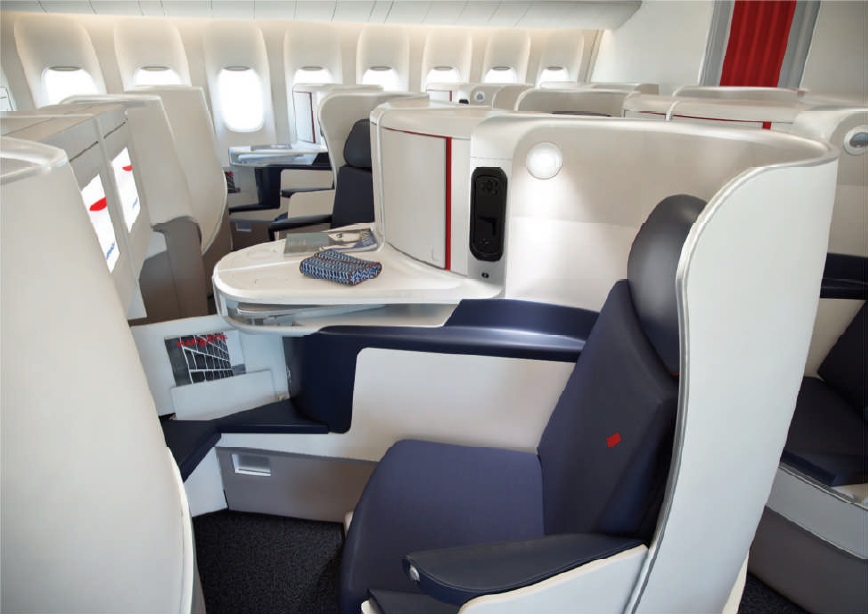Business travellers never stand still, nor do airlines courting them. As we move into the second half of 2018, here’s a look at the next generation of business class seats arriving in the coming 18-24 months.
British Airways’ new Airbus A350 Club World business class
BA has been beavering away on a replacement for its current Club World business class seats for several years now. There’s been a flurry of patents and concepts, plus this leaked design showing a modernisation of the current decade-old seat.
But the new Club World business class seat is almost here, and «it really is something else,» teases British Airways CEO Alex Cruz
It will break cover in early 2019, ahead of its early 2019 debut on the airline’s new Airbus A350-1000 fleet and more than a dozen years since the November 2006 launch of the Oneworld member’s current Club World seat, which adopted a controversial ‘high density’ approach to maximise the number of passengers in the available space, as well as a relatively unique forwards-backwards seating layout.
BA has recently been conducting closed-door tests of its next-gen Club World seat in a mock-up cabin.
In addition to providing direct aisle access for all passengers, the new seat will come with more storage built around specific items including water bottles and reading glasses, and reportedly more privacy.
Turkish Airlines’ new Airbus A350, Boeing 787 business class
Also lining up in 2019 is Turkish Airlines’ all-new business class seat, which will launch mid-year on the Star Alliance member’s Boeing 787 Dreamliners (below) and follow on a fleet of Airbus A350 jets.
As exclusively reported by Australian Business Traveller in September, the seat will follow a 1-2-1 layout – finally delivering direct aisle access to all passengers – with what an airline executive described as «high privacy… individual enclosed storage areas and 44-inch knee distance,» which some pundits believe points to a Vantage XL-based design from Thompson Aero Seating.
However, the seat will be exclusive to the Boeing 787s and Airbus A350s and won’t be retrofitted to the current Airbus A330, A340 or Boeing 777 fleet, which carries a mix of 2-2-2 and 2-3-2 in business class.
Turkish Airlines has signed up for as many as 30 Boeing 787-9 Dreamliners and 30 Airbus A350-900s, with the first six Dreamliners joining the fleet from mid-2019 followed by an initial five Airbus A350s from 2020.
And there’s still a chance that Turkish Airlines could begin flights between Istanbul and Sydney with its factory-fresh Boeing 787s.
Cathay Pacific’s new regional business class
Cathay Pacific’s regional sibling Cathay Dragon will also use the debut of a new jet – in this case, the Airbus A321neo – to launch a new business class seat.
The first of 32 A321neo aircraft in Cathay Dragon stripe are expected to head to Hong Kong at the end of 2019 or early 2020, and its new business class seat and may also appear on some of Cathay Dragon’s regional jets.
But whatever improvements it brings over today’s business short-range class seat (show below), converting into a lie-flat bed won’t be among them.
“We are in the early stage of design of the product for the A321neo but we’re very excited about that. It will be a next-generational product for Cathay Dragon.”
However, passengers can expect the new seat to be a recliner rather than adopt a fully lie-flat design.
“I think it will be most likely reclinable because it is a narrow-body aircraft,” Vivian Lo, Cathay Pacific’s Head of Customer Experience & Design, told Australian Business Traveller earlier this year.
Instead, look for changes central to the passenger experience in technology and convenience, and evolution rather than revolution in design.
“Our average regional sector length for Cathay Dragon is two hours, for Cathay Pacific it’s three hours, so at the moment we think we’ve got a very comfortable product for that service,» says Cathay Pacific CEO Rupert Hogg, who added that Cathay Dragon’s A321neo jets will adopt «a two-class configuration of about 200 seats”.
Lufthansa & Swiss: new Boeing 777X business class
Lufthansa will adopt a unique layout for the business class seats of its Boeing 777-9 jets, which will begin flying from 2020, with the seat also making its way to siblings Swiss and Austrian Airlines.
Not only will there be direct aisle access for every passenger, but an alternating 1-2-1 and 1-1-1 pattern means that every second middle seat will be a solo ‘throne’ seat offering additional privacy plus added personal space on either side of the passenger.
The seats adjacent to the window will be staggered, with half the passengers located at the aisle while a bench sits between the passenger and the window, while the others are located directly next to the window, with a bench between their seat and the aisle.
The console next to each seat will include a wireless charging pad, with a removable tablet docked into the wall of each seat providing control over everything from the inflight entertainment and seating position to lighting and ventilation.
Most seats will convert into fully-flat beds 2.2 metres long, although those central thrones will measure a more modest 2 metres.
Singapore Airlines’ new Boeing 737 MAX business class
2020 will see Singapore Airlines’ regional arm SilkAir folded back into its parent airline – a move which will coincide with the adoption of lie-flat business class seats across its Boeing 737 MAX 8 and Boeing 737-800 jets.
The rationale is that, once the SilkAir fleet is dressed in the iconic colours and Kris logo of Singapore Airlines, these business class flat beds will deliver a consistent ‘premium experience’ across both international and regional Singapore Airlines flights…



